Bamboo Clothing Market Research, 2032
The global bamboo clothing market size was valued at $1.3 billion in 2022, and bamboo clothing market forecast to reach $3 billion by 2032, growing at a CAGR of 9.1% from 2023 to 2032.
Around 2001, bamboo apparel and fabric made their debut in the market. They have a remarkable soft feel that combines the greatest qualities of both silk and fine cotton. The garment and textile industries were predicted by the new material to undergo a revolution. The fabric is seen as a more environmentally benign option than pesticide-intensive cotton or petroleum-based synthetics due to rapid growth and renewability of bamboo plants.
Most of the bamboo clothing made in the present, is made from Moso bamboo, which grows in vast forests in China. Bamboo flourishes in its natural environment without the use of pesticides or fertilizers. Bamboo may be continuously harvested without needing to be replanted, since it is grass. Every year, new shoots emerge and develop to their maximum height in one growth season, or around 60 days. In addition, Moso bamboo can grow to a height of 100 feet.
Bamboo may be challenging to confine because of how rapidly its rhizome roots expand. Nevertheless, bamboo quickly regrows after being harvested. It grows back stronger and healthier, compared to the normal grass on the front yard after a proper cutting. In addition, bamboo naturally grows in broad swathes such as this. In other words, a bamboo forest in its natural state resembles a bamboo farm. In addition to displacing other weeds and plants, bamboo grows thickly and produces plenty of fallen leaves that feed the soil.
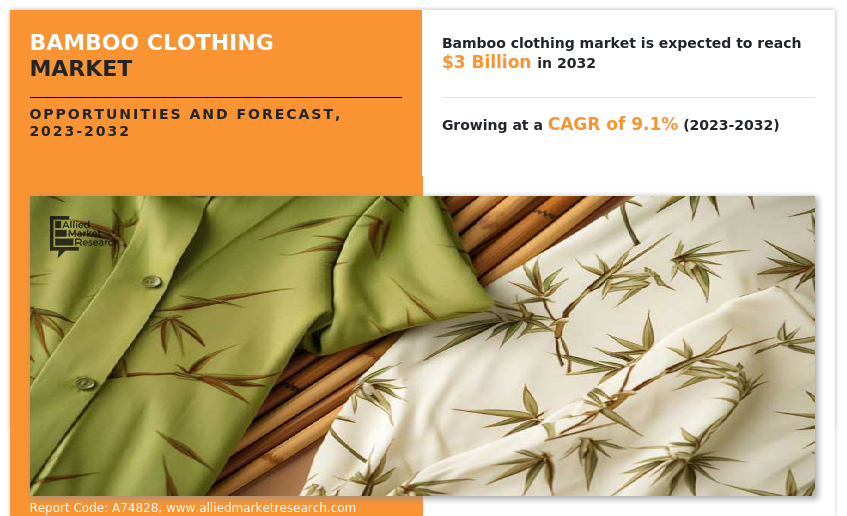
Bamboo can grow in a variety of settings, from hot and muggy environments to temperate ones. A temperature between 20 and 30 °C and between 1000 and 2000 mm of precipitation are ideal for the growth of bamboo. Bamboo is found in a range of latitudes between 40° south and north on every continent besides Europe. Eighty percent of bamboo regions are found in Asia. Asia-Pacific has the highest species richness, followed by South America with over 900 bamboo species separated into 65 generals. The fewest species of bamboo are found in Africa. Bamboo can grow anywhere in the world, except Antarctica and Europe, and Asia has the greatest variety of bamboo species. One of the main reasons that bamboo clothing prices remain high is thus the limited availability of bamboo plants, which hampers the bamboo clothing market growth.
Traditionally companies were focused on the linear economic model to manufacture the product. In traditional or linear approach, manufacturers procured their raw materials from extraction or tend to produce agricultural resources. Then they used to transform these materials and resources into final products, with the creation of trash. Moreover, to do the process these companies were using fresh water and there was minimum recovery or usage of waste being done by manufacturers. This has caused a significant impact on the environment including, greenhouse gas emissions from the extraction of these resources, the depletion of non-renewable resources, the destruction of biodiversity for agricultural resource production, contamination of the soil, water, or air brought on by the disposal or storage of waste.
The circular economy emphasizes efficiency and sustainability at every level of production and promotes upcycling, recycling, and reusing whenever practical, contrary to this linear approach. Every step of the process, including production, consumption, and end-of-life, must be considered using this strategy. Thus, the increased focus of manufacturers toward a circular economy is expected to create an opportunity in bamboo clothing market.
There is a significant rise in the consumption of clothing products by people aged between 18 and 25 years. The approximate number of middle and old-aged men has remained the same, whereas there is an increase in the number of women. According to the United Nations, the global youth population is expected to increase by 7% to 1.3 billion before 2030, which in turn is expected to drive the bamboo clothing industry.
Many companies have a dress code that emphasizes professionalism, particularly in formal or corporate contexts. This frequently translates to professional or informal business clothes. Dresses, skirts, blouses, jackets, and closed-toe shoes are options for women. Usually, the emphasis is on seeming professional, conventional, and acceptable for the workplace. Many working women place a high value on comfort and usefulness when selecting clothing, especially if their jobs require them to put in long hours or engage in physical activity. This might result in a predilection for breezy clothing, comfortable footwear, and useful accessories. Thus, surge in young population and increase in demand for comfortable clothing options from working women population are the factors that boost the bamboo clothing market demand.
The demand for products that are not only good for human beings but also good for the environment and sustainable has created an opportunity in bamboo clothing market. For almost 20 years, the Australian company Boody has been manufacturing a broad range of bamboo pants, shirts, and leggings. They launched a brand of lyocell bamboo pants called Lyolyte in 2021, and their gorgeous bamboo clothing is sold all over the world. Furthermore, in June 2023, Kora, pioneer in developing performance apparel with yak wool announced the launch of activewear range: Kora bamboo. Midweight Kora Bamboo fabric naturally wicks away moisture to keep the body cooler as temperatures rise and is wonderfully soft, strong, and breathable. With its ability to quickly switch between activities and climates, Kora Bamboo is a flexible option for daily wear. Bamboo is a soft fiber and a great plant-based substitute for wool for individuals with sensitive skin.
Since bamboo fabric is soft and stretchy by nature, which brings a variety of opportunities for bamboo clothing market, innovations such as stretchable and quick-drying fabric offer immense opportunities for market players to increase their share and strengthen their foothold in the competitive market. In addition, stretchy fabric is a recent development in this sector, and consumers prefer it for the level of comfort it provides. Companies are always working to improve fabric, which is projected to present profitable chances for the expansion of the worldwide market. Bamboo clothing is made from bamboo fibers derived from bamboo
In addition, bamboo is also relatively easy to produce alternatives to cotton that does not use pesticides or herbicides. One of the crops that need the highest chemical input to grow is cotton. Cotton that is raised in monocultures is far more prone to disease and pests. Therefore, unlike cotton, bamboo grows large and robustly without the need of pesticides, herbicides, or fertilizers. In fact, bamboo is among the impressive plants with the highest growth rates. Commercial types frequently grow one foot each day during the growth season. The tropical bamboo plant under perfect climate conditions can grow two or three times faster than commercially grown plants. The high yield of bamboo crop further propels the bamboo clothing market across the globe.
The bamboo clothing market statistics is done by product type, end-user, distribution channel, and region. On the basis of product type, the bamboo clothing market is categorized into t-shirts and shirts, pants, activewear, coats and jackets, dress, undergarments, and others. On the basis of end user, it is categorized into men, women, and kids. On the basis of distribution channel, the bamboo clothing market is categorized into supermarkets and hypermarkets, independent retail stores, e-commerce, and specialty stores. On the basis of region, the bamboo clothing market is analyzed across North America (the U.S., Canada, and Mexico), Europe (Germany, France, the UK, Italy, Spain, and Rest of Europe), Asia-Pacific (China, India, Japan, South Korea, Australia, and Rest of Asia-Pacific), and LAMEA (Latin America, Middle East, and Africa).
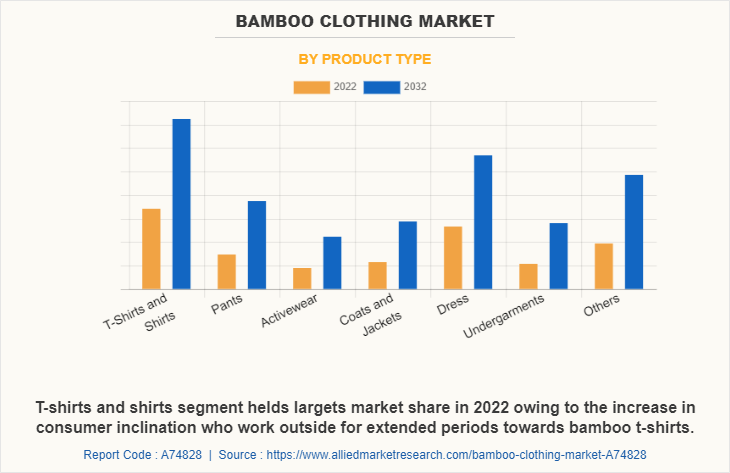
By product type
On the basis of product type, t-shirts and shirts garnered highest bamboo clothing market share in 2022 with a CAGR of 8.02%. Shirts made of bamboo are often resistant to fading. This has the advantage of ensuring that incredibly soft, super supple bamboo t-shirts maintain their appearance and color over time. In addition, the skin may not be exposed to the rays and UV radiation of the sun in the same manner as other materials do. One of the reasons customers who spend a lot of time working outside choose bamboo over other textiles for their work clothing is because of this. They prevent overexposure to the sun without adding any more chemicals to skin of consumers as they are already naturally protected.
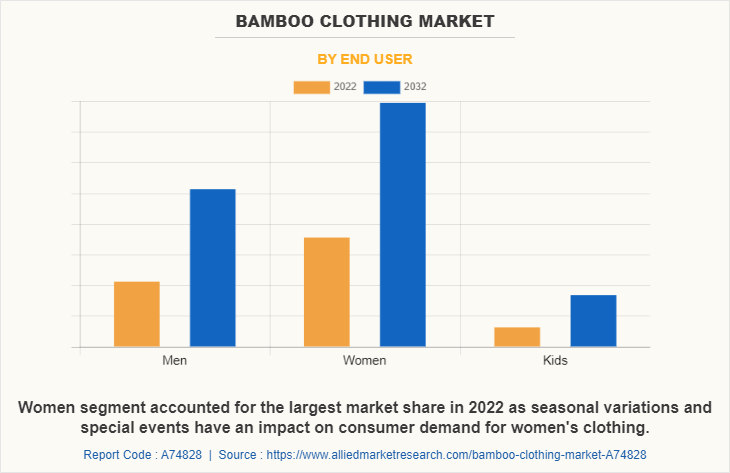
By end user
On the basis of end user, the women segment was the highest revenue contributor in 2022 and is expected to reach $1,587.41 million by 2032 at a CAGR of 8.59%. The largest end user for bamboo clothing are women. One key area where bamboo thrives is simplicity, and comfort is unquestionably hot right now. Basic t-shirts worn by women are trendy right now since they may be dressed up or down. Numerous colors may be added, and the design of the t-shirt may be slightly altered. There are many bamboo clothing items including T-shirts, dresses, jackets, among others that are always in style.
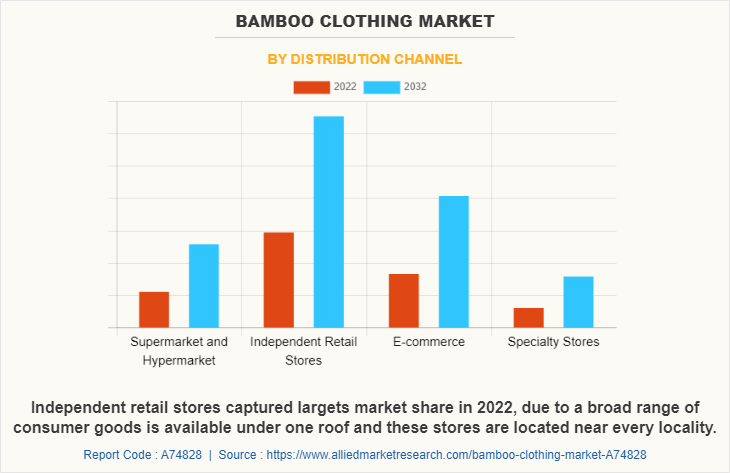
By distribution channel
On the basis of distribution channel, the independent retail stores segment was the highest revenue contributor in 2022 and is expected to reach $1,305.9 million by 2032 at a CAGR of 8.52%. Customers choose this type of shopping since it is easy for them to purchase from and because the prices these businesses charge are reasonable. These businesses are also well-located, which increases their appeal and spurs the expansion of the market. In addition, manufacturers are always working to improve their products shelf exposure; as a result, they primarily target independent retail outlets. As a result, these shops provide a greater selection of bamboo clothing items.
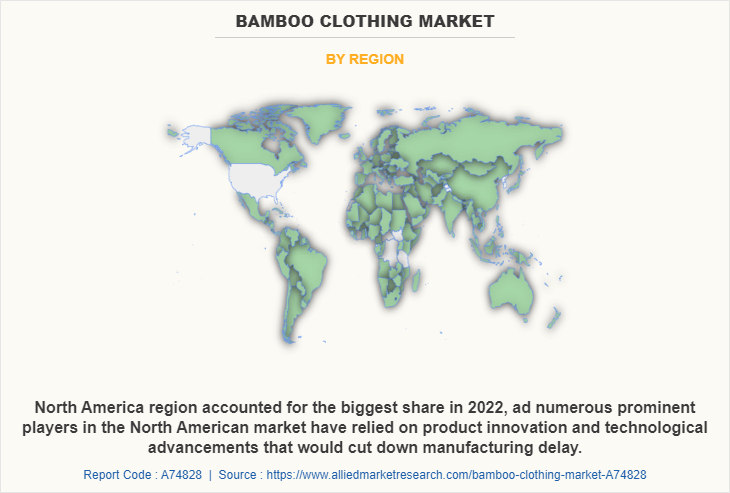
By region
On the basis of region, North America holds the largest share in bamboo clothing market i.e., $510.51 million in 2022, and is expected to reach $974.94 million by 2032 at a CAGR of 6.89%. The market in North America has been consolidating due to intense rivalry. Market participants creative product introductions and alluring marketing and positioning tactics have propelled the expansion of the market. In addition, a rise in consumer health consciousness has been a key factor in the expansion of the market. The competition has grown in recent years due to the entry of new companies into the North American bamboo apparel sector. In addition, bamboo apparel has expanded, as a result of population increase and bettering lifestyles. Sales of bamboo apparel in this area are greatly boosted by the increase in purchasing power in the area.
Competitive Analysis
The market is being driven by factors such as rapid growth in infrastructural development as well as various advancements in developing countries. The major players operating in the global bamboo clothing are Ettitude Holdings, Inc., Hara The Label Pty Ltd, Terrera, Spun Bamboo LLC, Tasc Performance, Bamboo Clothing Ltd, Free Fly Fishing Company, LLC, Cozy Earth, LLC, Royal Apparel Inc., and Cariloha, Inc.
Some Examples of Product Launches in the Global Bamboo Clothing Market
- In May 2022, Bamboo Clothing Ltd launched the jersey bamboo sport trunks, in order to expand its bamboo-packing apparel offering.
- In March 2022, Cariloha, Inc., launched a new bamboo graphic tee collection in order to expand its portfolio.
Key Benefits For Stakeholders
- This report provides a quantitative analysis of the market segments, current trends, estimations, and dynamics of the bamboo clothing market analysis from 2022 to 2032 to identify the prevailing bamboo clothing market opportunities.
- The market research is offered along with information related to key drivers, restraints, and opportunities.
- Porter's five forces analysis highlights the potency of buyers and suppliers to enable stakeholders make profit-oriented business decisions and strengthen their supplier-buyer network.
- In-depth analysis of the bamboo clothing market segmentation assists to determine the prevailing market opportunities.
- Major countries in each region are mapped according to their revenue contribution to the global market.
- Market player positioning facilitates benchmarking and provides a clear understanding of the present position of the market players.
- The report includes the analysis of the regional as well as global bamboo clothing market trends, key players, market segments, application areas, and market growth strategies.
Bamboo Clothing Market Report Highlights
| Aspects | Details |
| Market Size By 2032 | USD 3 billion |
| Growth Rate | CAGR of 9.1% |
| Forecast period | 2022 - 2032 |
| Report Pages | 390 |
| By Product Type |
|
| By End User |
|
| By Distribution Channel |
|
| By Region |
|
| Key Market Players | Bamboo Clothing Ltd, Royal Apparel Inc, Tasc Performance, Cariloha, Inc., Terrera, Free Fly Fishing Company, LLC, Cozy Earth, LLC, Hara The Label Pty Ltd, Ettitude Holdings, Inc., Spun Bamboo LLC |
Analyst Review
As per the perspective of top-level CXOs, the global bamboo clothing market is expected to unleash attractive business opportunities in developing economies, however, it deals with challenges simultaneously. Developing economies are further expected to emerge as major markets for bamboo clothing in a decade with increase in per capita income.
Bamboo can be harvested when it grows and replenishes itself. Moreover, other naturally grown fibers for textile such as cotton require seasonal plantings in order to yield fiber. It is still a crop that grows more slowly and can only be grown in certain parts of the world though organic cotton might lessen some environmental impact issues brought on by fertilizers and pesticides. Thus, bamboo fiber has become more popular among clothing manufacturers.
Bamboo has a far larger potential to store carbon than other crops and grows swiftly and readily with less agricultural input. Young shoots may be sold as food, mature poles can be used for building, and the remaining material can be utilized to make fuel, charcoal, or pressed particle board. Paper and textiles may be made from bamboo fiber. Bamboo fiber has high hygroscopicity compared to other fibers, may reflect light, and limit the absorption of heat radiation which can be used to make garments. The fiber may be used alone or in conjunction with other materials such as silk and cotton fibers in the clothing industry.
The CXOs observations indicate that the activewear market is anticipated to expand significantly because of growth in fondness for sportswear among consumers. The expansion of the sports gear market is also aided by the rise in sponsored sporting events organized by public and commercial institutions to increase the involvement of young people from developing nations. In addition, it is projected that an increase in the frequency of direct-to-consumer commercials would fuel industry expansion. The e-commerce industry has made it possible for customers to get special bamboo apparel at reduced prices, driving up overall sales of bamboo clothes.
The global bamboo clothing market size was valued at $1,260.52 million in 2022.
T-shirts and shirts is the leading product type of Bamboo Clothing Market
Environmentally friendly materials, achieving economies of scale by manufacturers, rapid growth of the online retail sector, high profit margins by manufacturers, and pressure on reducing carbon footprint are some of the upcoming trends of Bamboo Clothing Market in the world.
North America is the largest regional market for Bamboo Clothing.
Women are major target audience for Bamboo Clothing.
Ettitude Holdings, Inc., Hara The Label Pty Ltd, Terrera, Spun Bamboo LLC, Tasc Performance, Bamboo Clothing Ltd, Free Fly Fishing Company, LLC, Cozy Earth, LLC, Royal Apparel Inc., and Cariloha, Inc are the top companies to hold the market share in Bamboo Clothing.
Loading Table Of Content...
Loading Research Methodology...



